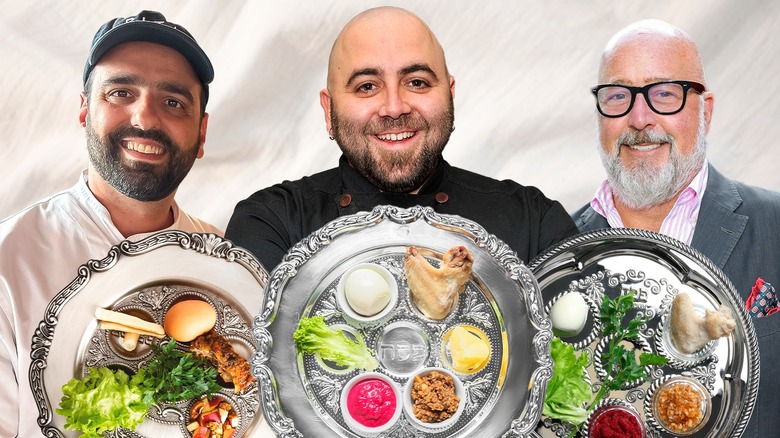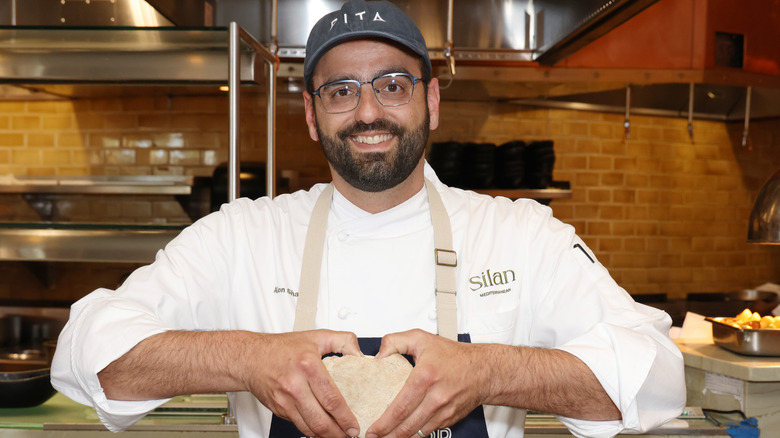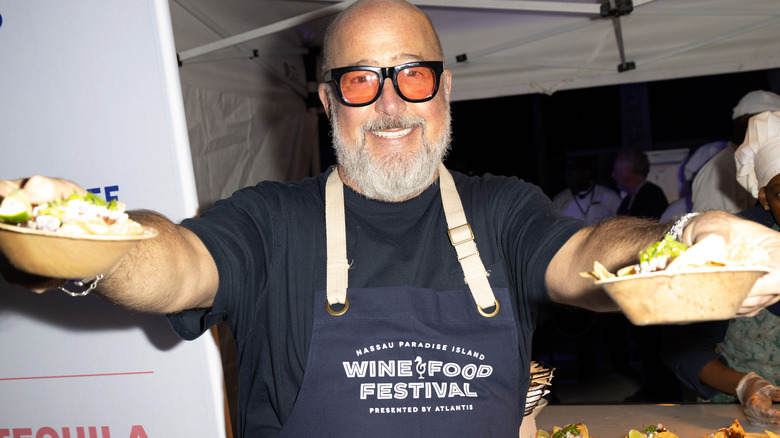How 3 Celeb Chefs Doctor Up Their Passover Meals
Jewish holidays have a set menu wherein each dish represents an event in Jewish history. Passover celebrates the Jews' freedom from slavery and the decades-long journey through the desert to achieve it. The first night of this eight-day holiday involves a massive seder or feast, with families gathering to tell the story of this epic biblical exodus. The telling of the story is punctuated by sips of wine and ritualistic nibbles of ingredients that symbolize key events. Then, a large feast ensues, with iconic Passover recipes like matzo-ball soup, brisket, gefilte fish, and potatoes.
While there's no messing with tradition when it comes to kosher laws and culinary symbolism, modern Jewish chefs have found clever and creative ways to doctor up their Passover meals. During the second annual Nassau Paradise Island Wine and Food Festival, Tasting Table got an exclusive glimpse into the seder menus of celebrity chefs Duff Goldman, Alon Shaya, and Andrew Zimmern. Each chef shared inspiring insight on how they put a refreshingly nuanced spin on recipes, meal plans, and culinary symbolism without breaking tradition.
Duff Goldman's take on Ashkenazi vs. Sephardic Passover food
Baker extraordinaire, owner of Charm City Cakes, and star of the former hit Food Network series "Ace of Cakes," Duff Goldman doesn't just upgrade a recipe, but instead changes the entire Passover menu. He informs Tasting Table that his Jewish ancestry is Ashkenazi, referring to geographical origins in Eastern Europe, France, and Germany. While traditional Ashkenazi seder dishes feature "brisket and matzah balls," Duff switches up the seder he grew up eating by swapping geographical Jewish cooking traditions, using classic seder recipes from Southern European and Middle Eastern Sephardic customs.
He thus swaps brisket and matzo ball soup for more exotic dishes "... like keftedes, and little lamb meatballs, and lots of sesame." He even puts a Sephardic twist on the symbolic seder plate staple, charoset, a sweet fruity, nutty salad soaked in wine that represents the clay enslaved Jews used to lay bricks as they labored under Egyptian rule. An Ashkenazi recipe for charoset usually utilizes ingredients native to Europe like apples and walnuts, with a mixture of red wine and cinnamon to season. Sephardic charoset is more elaborate, using extravagant spice mixtures, pomegranate molasses, nuts, and dried fruits native to the Middle East. Following this Sephardic tradition, Duff states, "My harosets has dates, and apricots, and almonds, and pistachios."
Alon Shaya puts an edible spin on the symbolic seder plate
Alon Shaya, an Israeli-born restaurateur and five-time James Beard Award nominee employs a delicious twist on the traditional Seder plate, a collection of foods that have more symbolic than culinary value at the Passover table. Shaya told Tasting Table that he "like[s] making the seder plate that's all super delicious and edible."
A seder plate usually consists of matzo, bitter herbs, a hard-boiled egg, parsley and saltwater, charoset, and a lamb bone. Every food that makes up a traditional seder meal represents an aspect of the Passover story, whether it be an event, an object, or a spiritual takeaway. While these items are technically edible, they're not necessarily delicious. So Shaya transforms each item into the main ingredient of a more ornate dish. For example, he swaps a lamb bone for slow-cooked lamb ribs, pickles the hard-boiled egg, and makes a horseradish dip from scratch "by grating horseradish root and seasoning it with juniper berry and fresh bay leaf and chili, and thyme."
Instead of dipping parsley in saltwater, Shaya showcases parsley as the key ingredient in an herby tabbouleh. He even makes the most of the bitter herb requirement by using escarole tossed in "a little olive oil and lemon juice." With roots in Israel, Shaya also follows a Sephardic recipe for charoset. However, his recipe is even more elevated, featuring dates, figs, dried apricots, and hazelnuts drowned in "vin santo or dessert wine."
Andrew Zimmern gives fancy upgrades to seder classics
Famous for taking adventurous eating to the farthest extreme, "Bizarre Foods" host, world traveler, and celebrity chef Andrew Zimmern is a fan of improving upon the classics. He gushes about his seasonal twist on charoset that he starts to prepare almost a year in advance. His secret is coating the apples in "a homemade plum syrup" made during the summer from a local harvest of black friar plums that he freezes until seder the following spring. He also recommends simpler tweaks like toasting the nuts before you add them to the charoset for a more robust savoriness and heightened crunch.
Zimmern emphasizes the virtues of the old-fashioned yet tasty ingredient known as shmaltz, or rendered chicken fat, which he argues is the secret to good matzo balls. It's also the key ingredient in chopped liver, another Passover table mainstay. Another matzo ball tip he mentions cryptically is club soda. After further investigation, the baking soda element and carbonation of club soda means it's a longstanding hack that'll make matzo balls especially light and fluffy. Zimmern opines that a nice matzo ball is not "a sinker, it's also not a floater," but instead lies somewhere in between.



